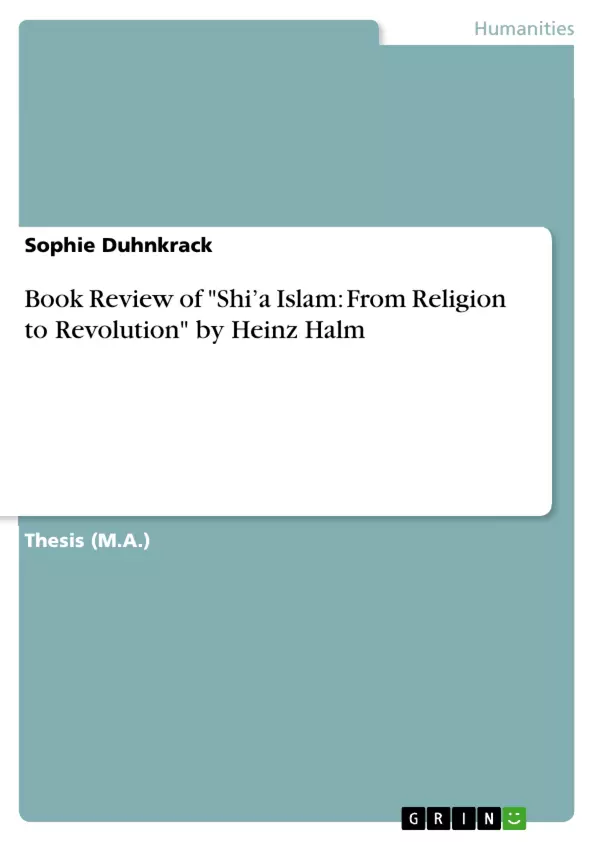Professor Heinz Halm’s work Shi’a Islam: From Religion to Revolution deals with the origins and developments of Shi’ism in general and the Shi’i history of Iran, with special attention paid to the Iranian Revolution, which gave rise to the Islamic Republic of Iran. Professor Halm’s study aims to synthesize these two major thematic blocks which are located in quite distant historical periods. Within the analysis of Shi’ism the author depicts the major rituals and their history, utilizing travelogues and descriptions of majorly European observers. He compares and examines historical processes which led to the revolution, as well as the revolution itself and its outcome on the basis of previously described characteristics of Shi’ism.
. Firstly this article will give a short presentation of the book’s structure and a summary of its contents. Further on, it will compare the work with Jonathan Berkey’s The Formation of Islam and Ervand Abrahamian’s Khomeinism: Essays of the Islamic Republic of Iran in order to examine different approaches and interpretations of various issues covered by all three works. Successively the article will focus on the methodology, the use of sources and the style of Shi’a Islam and it will conclude with some criticism and suggestions for further reading in this field.
Inhaltsverzeichnis (Table of Contents)
- The Early History of Shi'ism
- Early Tensions in the Muslim Community
- The Line of the Eleven Imams
- Basic Concepts of Shi'ism
- The Return of the Mahdi
- The Ashura Ritual and its Significance
- European Reports about the Ashura Celebrations
- The Elegy and the Passion Play
- Chest Beating and Flagellants
- Shi'ism in the Post-Imam Era
- The Emergence of the Ulama
- The 'Iranian Intermezzo' and the Buyid Rule
- The Seljuks, Mongols, and their Impact on Iranian Religious Life
- The Shi'i Clergy under the Safavids
- The Rivalry between Monarchy and Clergy
- The 19th Century and the Iranian Struggle Against the West
- The Constitutional Revolution of 1906 and the Rise of the Ulama
- Shi'ism's Revolutionary Characteristics
- The Islamic Revolution of 1979 and the Role of Khomeini
Zielsetzung und Themenschwerpunkte (Objectives and Key Themes)
This book aims to provide a comprehensive overview of Shi'a Islam, tracing its origins and development from its earliest beginnings to its role in the Iranian Revolution. It seeks to understand how Shi'a beliefs and practices shaped Iranian history and ultimately led to the establishment of the Islamic Republic of Iran.- The origins and evolution of Shi'a Islam
- Key Shi'a concepts and practices, such as the role of the Imams, the Ashura ritual, and the concept of ijtihad
- The historical and political context of Shi'ism in Iran
- The rise of the Ulama and their role in the Iranian Revolution
- The impact of Shi'a Islam on contemporary Iran
Zusammenfassung der Kapitel (Chapter Summaries)
The first part of the book explores the early history of Shi'a Islam, focusing on the emergence of Shi'a thought and practice during the early Islamic period. It covers the lives and legacies of the twelve Imams, as well as key concepts such as the tragedy of Karbala and the return of the Mahdi. The second part delves into the Ashura ritual, examining its historical and religious significance and exploring its evolution from earlier forms to its contemporary manifestations. The third and final part delves into the development of Shi'a Islam in the post-Imam era, tracing the rise of the Ulama, the impact of various rulers on Shi'a practice, and the eventual emergence of Shi'a Islam as a dominant force in Iranian society leading up to the Iranian Revolution.Schlüsselwörter (Keywords)
This study primarily focuses on Shi'a Islam, its historical development, its key concepts and practices, and its role in shaping the political landscape of Iran. Important themes include the Imams, the Ashura ritual, ijtihad, the Ulama, and the Iranian Revolution.- Quote paper
- Sophie Duhnkrack (Author), 2009, Book Review of "Shi’a Islam: From Religion to Revolution" by Heinz Halm, Munich, GRIN Verlag, https://www.grin.com/document/127500



